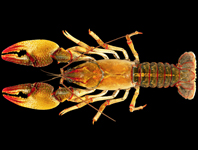Abstract
The number of antennal segments in adults of the different families and genera in the insect order Thysanoptera varies between five and nine. The plesiotypic number is considered to be nine (Zhang et al. 2019), and fossil thrips reported to have 10 to 15 segments (Tong et al. 2019) are generally considered to be aberrations in which the terminal segment bears transverse striae. The 9-segmented condition occurs particularly amongst species that exhibit several other characters in a plesiomorphic state, including all Melanthripidae, two genera of Merothripidae, also most species of Fauriellidae, Stenurothripidae, Heterothripidae, and Aeolothripidae (Mound et al. 1980). Curiously, members of a few genera of Thripidae (Palmer & Mound 1985; Minaei 2012) also have nine antennal segments, but this is considered a reversion from the 8-segmented condition that is assumed to be plesiomorphic for that family (Zhang et al. 2019). Variation between eight and nine segments occurs in the genus Anaphothrips, and within that genus a few species exhibit intraspecific variation in antennal segmentation (Mound & Masumoto 2009). Intraspecific variation in various characters, including body size, color and wing length, is well documented for the order Thysanoptera (Mound 2005 a, b). However, amongst the 207 listed species of Aeolothripidae there has never been any report of a species bearing antennae with other than nine segments, although these vary in length and shape amongst the different genera. We here describe from Iran a curious species of the genus Aeolothrips that is unusual in having only seven antennal segments, with the number reduced to six or even five in a few individuals in which the terminal segments are fused. These females with 7-segmented antennae were initially considered to be aberrant individuals of some other species. However, 25 females with such antennae have been collected over two years, all from a group of Tamarix trees. Despite extensive studies on the genus Aeolothrips in Iran (Alavi & Minaei 2018, 2019), with 30 species now being recorded from this country, no other species has been found with the same colour pattern of the body and fore wings. We therefore conclude that the available specimens represent a valid species in which the antennal segmentation is reduced, and with the terminal segments unstable.
References
Alavi, J. & Minaei, K. (2018) Studies on the genus Aeolothrips (Thysanoptera: Aeolothripidae) in Iran, with a key to species. Zootaxa, 4446 (3), 343–360.
https://doi.org/10.11646/zootaxa.4446.3.3
Alavi, J. & Minaei, K. (2019) Two new species and a new record species of the genus Aeolothrips (Thysanoptera: Aeolothripidae) from Iran. Turkish Journal of Zoology, 43, 349–355.
https://doi.org/10.3906/zoo-1903-16
Minaei, K. (2012) Ficothrips, a new genus of Thripinae Thysanoptera from Iran. Zootaxa, 3361, 63–68.
Mound, L.A. (2005a) Fighting, flight and fecundity: behavioural determinants of Thysanoptera structural diversity. In: Ananthakrishnan, T.N. & Whitman, D. (Eds.), Insects and phenotypic plasticity. Science Publishers Inc., Enfield, New Hampshire, pp. 81–105.
Mound, L.A. (2005b) Thysanoptera – Diversity and Interactions. Annual Review of Entomology, 50, 247–269.
https://doi.org/10.1146/annurev.ento.49.061802.123318
Mound L.A., Heming, B.S. & Palmer, J.M. (1980) Phylogenetic relationships between the families of recent Thysanoptera. Zoological Journal of the Linnean Society of London, 69, 111–141.
https://doi.org/10.1111/j.1096-3642.1980.tb01934.x
Mound, L.A. & Masumoto, M. (2009) Australian Thripinae of the Anaphothrips genus-group (Thysanoptera), with three new genera and thirty-three new species. Zootaxa, 2042 (1), 1–76.
https://doi.org/10.11646/zootaxa.2042.1.1
Palmer, J.M. & Mound, L.A. (1985) New World Thripidae (Thysanoptera) with nine-segmented antennae. Zoological Journal of the Linnean Society, 84, 181–194.
https://doi.org/10.1111/j.1096-3642.1985.tb01798.x
Pelikan, J. (1963) New Thysanoptera from Central Asia (U.S.S.R.). Časopis Československé Společnosti Entomologické (Acta Societatis Entomologicae Cechosloveniae), 60, 99–113.
ThripsWiki (2019) ThripsWiki—providing information on the World’s thrips. Available from: http://thrips.info/wiki/Main_Page (accessed 15 July 2019)
Tong, T.T., Shih, C.K. & Ren, D.Y. (2019) A new genus and species of Stenurothripidae (Insecta: Thysanoptera: Terebrantia) from mid-Cretaceous Myanmar amber. Cretaceous Research, 100, 184–191.
https://doi.org/10.1016/j.cretres.2019.03.005
Zhang, S.M., Mound, L.A. & Feng, J.N. (2019) Systematic significance of antennal segmentation and sense cones in Thripidae (Thysanoptera: Terebrantia). Zootaxa, 4554 (1), 239–254.
https://doi.org/10.11646/zootaxa.4554.1.8
zur Strassen, R. (2003) Die terebranten Thysanopteren Europas und des Mittelmeer-Gebietes. Die Tierwelt Deutschlands, 74, 1–271.

